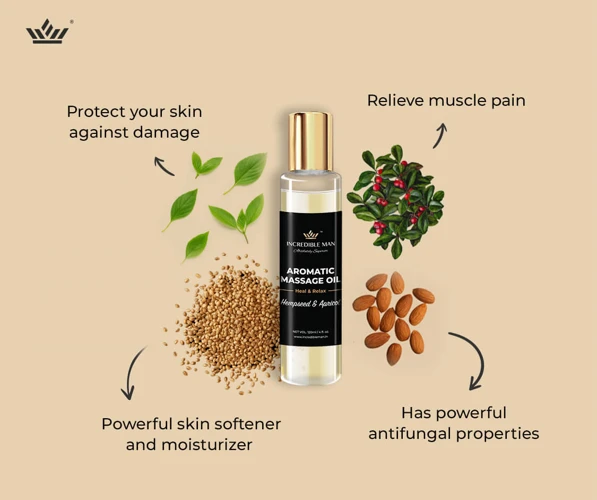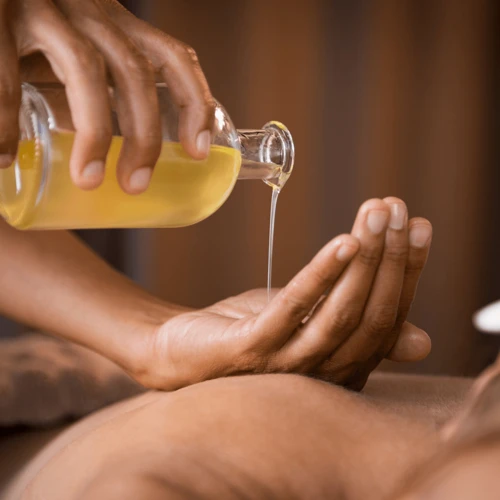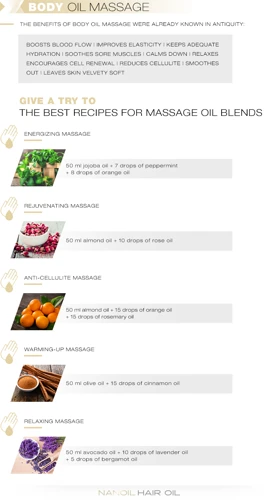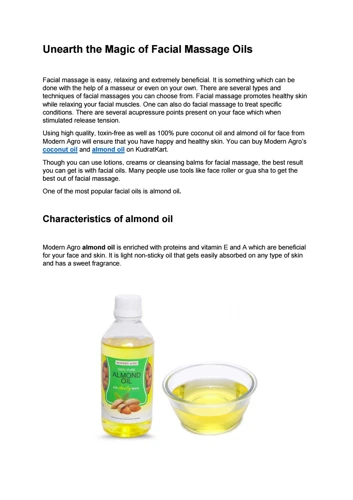If you’re looking for a natural way to promote relaxation, relieve muscle tension, and improve overall health, you may be wondering: what is the purpose of massage oil? Massage oil is a type of essential oil often used in massage therapy to help reduce friction during massage, nourish the skin, and promote relaxation. Massage oil can also help reduce stress, improve circulation, and alleviate muscular pain and stiffness. In this article, we’ll explore the benefits and uses of massage oil so you can make an informed decision on whether or not it’s right for you.
Benefits and Uses of Massage Oil

Physical Benefits
Massage oil helps to improve circulation, reduce inflammation, and relieve soreness and pain. It can help to relax the muscles and improve flexibility, making it easier to perform activities that require physical strength. Massage oil can also be used to help soothe and heal minor cuts and abrasions. Additionally, massage oil can help to improve the overall texture of the skin by moisturizing and providing a protective barrier against environmental damage.
Mental Benefits
Massage oil can provide a calming and soothing effect that can help to reduce stress and anxiety. It can help to improve mental clarity and provide a sense of relaxation and wellbeing. Many people use massage oil to help them relax, reduce pain, and improve their overall physical and mental health.
How does oil massage help? Oil massage provides a variety of benefits that can help to improve physical and mental health. It can help to reduce inflammation, improve circulation, and relieve soreness and pain. Additionally, massage oil can help to reduce stress, improve mental clarity, and provide a sense of relaxation and wellbeing.
How Does Oil Massage Help?

Physical Health Benefits
Oil massage promotes relaxation, relieves muscle tension, and helps improve circulation. It increases flexibility and range of motion, and can help reduce pain, inflammation and stiffness. Oil massage also helps improve skin tone, making it soft and supple.
Mental Health Benefits
Oil massage can help reduce stress and anxiety, and promote a sense of wellbeing. It can also help enhance mental clarity, improve sleep quality, and even help improve mood.
Different Types of Massage Oils

- Apricot Oil: Apricot oil is a light and gentle oil that is rich in vitamins A, B1, B2, B6 and E, minerals, and fatty acids. It is great for dry and sensitive skin, and helps to improve skin elasticity. It is also a great carrier for essential oils.
- Avocado Oil: Avocado oil is a rich oil that is high in vitamins A, B1, B2, D, and E, essential fatty acids, and minerals. It is great for moisturizing, nourishing, and protecting the skin. It is also a great carrier for essential oils.
- Coconut Oil: Coconut oil is a light and fragrant oil that is high in vitamins A, B1, B2, and E, essential fatty acids, and minerals. It is great for moisturizing, nourishing, and protecting the skin. It is also a great carrier for essential oils.
- Jojoba Oil: Jojoba oil is a light and fragrant oil that is rich in vitamins A, B1, B2, and E, minerals, and essential fatty acids. It is great for moisturizing, nourishing, and protecting the skin. It is also a great carrier for essential oils.
- Olive Oil: Olive oil is a light and fragrant oil that is rich in vitamins A, B1, B2, and E, essential fatty acids, and minerals. It is great for moisturizing, nourishing, and protecting the skin. It is also a great carrier for essential oils.
- Sunflower Oil: Sunflower oil is a light and fragrant oil that is high in vitamins A, B1, B2, and E, essential fatty acids, and minerals. It is great for moisturizing, nourishing, and protecting the skin. It is also a great carrier for essential oils.
- Grapeseed Oil: Grapeseed oil is a light and fragrant oil that is rich in vitamins A, B1, B2, and E, essential fatty acids, and minerals. It is great for moisturizing, nourishing, and protecting the skin. It is also a great carrier for essential oils.
How to Choose the Right Massage Oil

When it comes to choosing the right massage oil, it’s important to find one that meets your specific needs. The type of oil you choose will depend on the type of massage you are receiving and the desired outcome. Here are a few tips to help you choose the right massage oil:
- Consider the type of massage. Different massage techniques require different oil types. For example, lighter oils are typically used for Swedish massage, while heavier oils are used for deep tissue massage.
- Choose an oil that is appropriate for your skin type. If you have sensitive skin, it is best to choose an oil that is hypoallergenic and free of fragrances. For dry skin, look for oils that are moisturizing and hydrating.
- Consider the scent. Aromatherapy massage oils can be used to help relax the body and mind. Choose an oil with a scent that you find pleasant and calming.
- Look for quality ingredients. Make sure that the oil you choose is high quality and free of any harmful chemicals. Natural and organic oils are best and can provide additional benefits, such as nourishing and moisturizing the skin.
By taking the time to choose the right massage oil, you can ensure that you get the most out of your massage. You can also make sure that your skin is properly nourished and hydrated.
How to Use Massage Oil

- Create a Relaxing Atmosphere: Dim the lights, light some candles, and play some calming music to create a peaceful and relaxing atmosphere for your massage.
- Warm the Oil: Heat up the massage oil to a warm temperature that is comfortable to the touch. This can be done by placing the bottle of oil in a bowl of warm water or using an electric oil warmer.
- Test the Temperature: Before applying the oil, test it on the back of your hand to make sure it is not too hot or too cold.
- Apply the Oil: Gently pour or rub the oil onto the skin in a circular motion. You can use your hands or a massage tool such as a roller or a brush.
- Massage: Use long, slow strokes to massage the oil into the skin. You can use a variety of massage techniques such as kneading, tapping, stretching and more.
- Clean Up: When you are done with the massage, make sure to wipe away any excess oil and dispose of the towels or sheets you used.
Tips for Choosing and Using Massage Oil

- Choose an oil that suits your skin type: Most massage oils are made from vegetable oils and have a light, non-greasy texture. If you have sensitive skin, look for oils that are specifically formulated for sensitive skin. If you have dry skin, opt for an oil that is more nourishing and hydrating.
- Choose an oil with the right scent: Many massage oils come in a variety of scents, from lavender to eucalyptus. Choose an oil with a scent that you find calming and relaxing.
- Choose an oil that is easy to apply: Look for an oil that is easy to spread and doesn’t leave an oily residue on the skin. An oil that is too thick will be difficult to apply and may leave you feeling greasy and uncomfortable.
- Use the right amount of oil: Too much oil can make the massage uncomfortable, while too little oil can make it difficult to massage the skin. Start with a small amount of oil and add more if necessary.
- Warm the oil before use: If possible, warm the oil before use for a more relaxing and soothing massage. You can do this by placing the bottle of oil in a bowl of warm water for a few minutes.
- Clean up after use: Make sure to clean up after use by wiping off any excess oil on the skin and laundering the towels used for the massage.
Safety Considerations for Massage Oil
Before using massage oils, it is important to consider safety factors such as allergies, skin sensitivity, and certain health conditions. Those with allergies should always check the label for potential allergens. People with sensitive skin should opt for hypoallergenic oils. Those with certain medical conditions, such as high blood pressure, diabetes, or cancer, should consult their doctor before using massage oils. Additionally, massage oils should not be used on broken or irritated skin. It is important to patch test a small area before using a new oil to ensure that it does not cause any irritation.
Frequently Asked Questions
What Types of Massage Oil Are Available?
Massage oil comes in a variety of types, including plant-based, nut-based, and mineral-based oils. Popular plant-based oils include sunflower, almond, jojoba, avocado, and coconut. Nut-based oils include argan, macadamia, and pecan. Mineral-based oils include grapeseed, apricot kernel, and safflower. Each type of oil has its own unique properties that make it ideal for specific types of massage. For example, almond oil is lightweight and easily absorbed, making it a great choice for Swedish massage. Jojoba oil is rich in vitamin E, making it a great choice for aromatherapy massage.
What are the Benefits of Using Massage Oil?
1. Increased Circulation: Massage oils help to increase the circulation of blood, which can help to reduce pain and inflammation.
2. Improved Muscle Relaxation: Massage oils help to relax the muscles, which can reduce pain and can improve overall muscle and joint mobility.
3. Enhanced Skin Health: Massage oils can help to nourish and moisturize the skin, helping to reduce wrinkles, blemishes, and skin irritation.
4. Improved Mood: Massage oils can help to reduce stress and anxiety and can help to improve your overall mood.
5. Increased Flexibility: Massage oils can help to increase flexibility and range of motion, which can help to improve overall physical performance.
Are there any potential side effects associated with massage oil?
Massage oil is generally safe to use, however there are some potential side effects to be aware of:
- Allergic reactions – Some people may experience allergic reactions to the ingredients in massage oil, such as nut oils, essential oils, or other potential allergens.
- Skin irritation – If the massage oil contains essential oils, some people may experience skin irritation due to the potency of the oils.
- Infection – If the massage oil is not properly cleaned and sanitized between uses, it could spread bacteria and lead to infection.
- Respiratory problems – Inhalation of massage oil, especially those containing essential oils, may cause respiratory problems.
It is important to speak with your doctor or health care provider before using massage oil, especially if you are pregnant, have allergies, or other health conditions.
Is Massage Oil Suitable for All Skin Types?
Massage oil is a great way to relax and unwind. But it can also be beneficial for your skin, providing moisture and hydration while helping to soothe, nourish and protect. While massage oil is generally suitable for all skin types, it is important to choose the right one for your individual needs. Here are some of the benefits of massage oil:
- Moisturizing: Massage oil helps to keep skin hydrated and supple, protecting it from dryness and flaking.
- Nourishing: Massage oil can help to nourish the skin, providing vitamins and minerals that are essential for healthy skin.
- Protection: Massage oil helps to protect the skin from damage caused by external factors such as sun, wind and pollution.
- Soothing: Massage oil can help to reduce inflammation, redness and irritation, making it great for sensitive skin types.
- Relaxing: Massage oil can help to ease tension, stress and pain, making it ideal for relaxation.
However, it is important to choose the right massage oil for your individual skin type. For example, those with oily skin should look for massage oil that is non-greasy and lightweight, while those with dry skin should opt for heavier, more nourishing oils. It is also important to remember that some essential oils can be too harsh for sensitive skin, so it is best to consult with a professional before using them.
What Essential Oils Are Commonly Added to Massage Oils?
Essential oils such as lavender, rosemary, eucalyptus, peppermint, and orange are commonly added to massage oils to provide a calming, soothing, and therapeutic effect. Other essential oils such as tea tree, lemongrass, and sandalwood have also been used to treat various ailments and can be added to massage oils for additional therapeutic benefits. Essential oils can also help to enhance the scent of the massage oils, providing a pleasant aroma for the massage session.
Conclusion
Massage oil is an essential part of massage therapy, as it helps increase glide, reduces friction, and provides a barrier between the skin and the massage tools. It is also beneficial for relaxation and calming the mind, as well as providing nourishment to the skin. Massage oil can be used for all kinds of massage, from deep tissue to relaxation, and can be blended with essential oils for an even more therapeutic experience.
📚 References
- Massage and Aromatherapy: Setting the Stage for a Holistic Approach to Health Care
- Massage Oil on Wikipedia
⚠️ Disclaimer:
This article is for informational purposes only and does not constitute medical advice. Always consult with a licensed healthcare provider or certified massage therapist before beginning any new treatment, especially if you have pre-existing health conditions or concerns.




